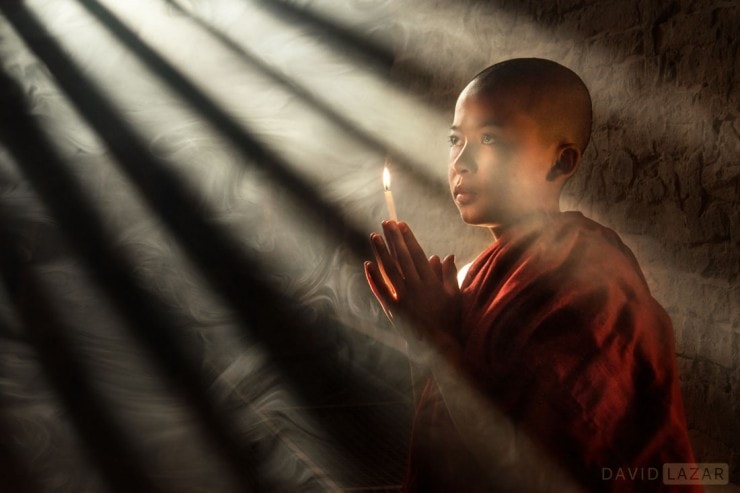David Lazar is an Australian travel photographer and musician, who captures the beauty of the world, moments of life and culture. He travels to the countries with a rich cultural background, traditions, and history.
David is a contributor to photography, travel and in-flight magazines, newspapers, books, and journals like National Geographic, Asian Geographic, and Lonely Planet. In 2014 he was awarded Best Culture Photographer by Garuda Airways. He has recently published the book “Myanmar A Luminous Journey’.
Impakter Magazine: David, tell us how did your story begin? When have you discovered your passion for photography?
David Lazar: My story began in 2004 when I went on a holiday to India with my cousin and a friend. We have been on tour around 2-3 months, and my cousin was using a film camera to capture the memories of the trip, which I really loved. It was very inspiring for me to see those photos.
After this trip, I have decided to buy my own camera, though I was not interested in photography at that time, that trip and travel photography influenced me a lot! I started to explore the works of other travel photographers, especially those who were capturing the portraits of people with different ethnicity and cultures. I feel so inspired and so emotional from looking at those pictures that I decided to start my photography adventure in this direction.
I have never studied photography, and I did not have any goals to be a photographer. I am a piano teacher and musician who was once inspired by the beauty and diversity of the travel photography.

How do you choose places for your visit?
D.L.: Every year when I go traveling, I want to visit exotic and unusual locations that inspire me. Years over years I go there, I practice my photography skills, but I experience also new things, like introducing myself to people and finding ways to approach them. It was hard in the beginning, but I got better every time.
Your style is a portrait photography with cultural background and ethnicity. Why exactly this style did you choose, not others?
D.L.: I believe, the artwork should be an expression of the emotion and a portrait photography fits perfectly for this statement. Moreover, I love people and taking pictures of them brings me pleasure. However, I like landscape and wildlife photography too. If to prioritize my preferences: portrait photography first and then landscapes with wildlife secondary.

You travel a lot. Bangladesh, India, Indonesia. How do you handle communication issues during your trips?
D.L.: Well, I think, finding communication with people is never a problem for me. Sometimes you just need to learn few words and phrases to break the ice, to say hello and how are you in the foreign language. Usually, I found that people overseas are really impressed and excited when I am speaking their language.
It is never a problem. I can also communicate with people just with facial expression, eye contact, smiling, making a joke without English or doing some magic coin tricks to make them laugh. I think expressing your emotions and be open is a big key for communication and connection with people. Then they can be more relaxed around you, you get to know each other better and then you can ask to take a photo of them.
Moreover, people can read each other, so it is important to be respectful and polite too. It helps me when I need to arrange the photo, I usually tell them how to stand and where to sit to adjust every detail to my already created idea of the picture.
Of course, there are some situations where I need a local guide and translator, but mostly I interact with people without any help.

Among countries you have visited there should be definitely a place that brought you more emotions, excitement, and experience. Do you want to share this story?
D.L.: Well, I think it is India. Here I had my first trip full of excitement and priceless memories, and India is so diverse, traditional, modest. However, I did not do so much photography there.
Speaking of the exciting place for photography, it was Myanmar the most Buddhist country in the world. Here are so many interesting and beautiful temples. People have unique ethnic faces. Interestingly, every boy in Myanmar should become a monk at some point in his life.
I can say, that Myanmar is an interesting object for photography. The country is so rich from the photography perspective. There I made a lot of great high-quality photos.

What makes a photo good?
D.L.: I think one of the most important things is a fascinating and engaging subject matter. Don’t choose a chair or a pen for your photography, choose something exciting and unique instead. For me, the first thing is to find people, landscape or scenes of life which are really interesting. I can identify straight away what kind of face I think will be compelling, and then I got ideas how to photograph them.
Then I need to come up with a great composition, and it is probably the hardest thing photographers may struggle with. You need to choose, how to show in a photo where your subject matter is positioning.
That´s really a big challenge, but it makes such a big difference. The pictures, which are really good or very powerful to look at them, are impactful.
Don’t forget about lighting too. Correctly chosen light or strong shadow will make a photo powerful as well.
So three things are essential for a good photo are the engaging subject matter, the composition, and the light. Over the years, it comes intuitively.

The portrait of the boy with green eyes appeared many times in different articles. Can you share a story behind it?
D.L.: It is a good example. This photo was made in Brazil. I met this boy at a cultural activity center for kids in Sao Paulo, which I was invited to come and visit, and they were doing a face painting activity. When I saw him, it was pretty easy to say that it will be a great photo. There was something in his facial expression and magnetic green eyes. I ask the kid not to smile, just be relaxed and look straight to the camera. That makes his face more intense and powerful.
When I am taking pictures, I a trying to avoid any distractions around, remaining the background, in this picture, only green leaves, as they are very complementary to his eye color. Choosing framework is also essential for a great photo. It should be integral to the clothing, face, eyes and be fit to your composition.

You published a book too. Can you tell us more about it?
D.L.: Yes, I wrote a book about my photography. It is a photo book that contains the collection of my Myanmar works. It is called “Myanmar a Luminous Journey.” You can find here my photos and a bit of text about locations and a map where the photo was taken from. This book is available at the airports of Myanmar and at some shops in South Asia.
What messages do you want to send to the world with your photos?
D.L.: I want to show the positive side of the world and humanity. I want to create an artwork which is beautiful and forms an emotional reaction but also can show and teach people about the diversity of cultures in other countries.
My photographic goal to uncover the hidden places in the world and show them in a positive light.

What are your next plans?
D.L.: I will continue working with Luminous Journeys as a photo tour leader, taking small groups of photographers to various countries in South Asia to exciting and culturally rich locations, working together to create wonderful pictures
All photo credit to David Lazar














